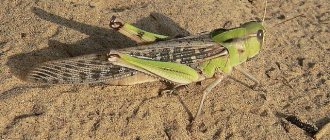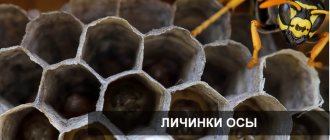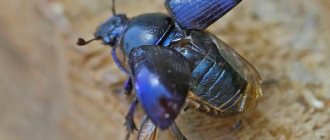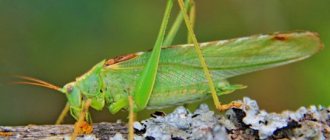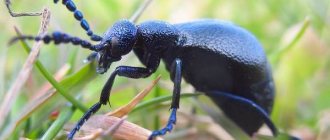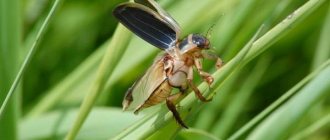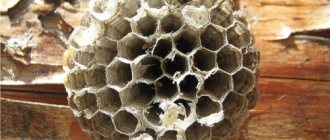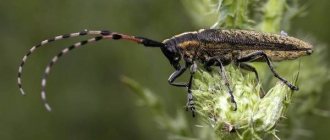Description and features
The scarab belongs to the subfamily of dung beetles, this is due to the fact that the beetle rolls balls of dung and moves them over long distances until it finds a suitable place to store its prey. By the way, the insect always rolls the ball in one direction - from east to west, just as the sun rises and sets.
That is why the scarab beetle in ancient Egypt was associated with the sun god, who in images had the body of a man and the head of a scarab. The insect in its hot homeland reaches a size of 4 cm, but in other habitats individuals are smaller - up to 2 cm.
The body of the beetle is convex, has a deep black color; in young scarabs it is matte, but with age it acquires a glossy shine. The head has a distinct frontal prominence with two eyes divided into paired lobes and a serrated clypeus.
On the back there are armor-like elytra, thanks to which the wings are protected from heat and damage. The beetle flies well even in the hottest hours of the day and is capable of reaching speeds of up to 11 km/h. The abdomen and paws are covered with vellus hairs, which differ in color in males and females - in the former they are red, in the latter they are black.
Since sexual differences are poorly developed in this species of insects, they are distinguished only by the difference in color and the slightly more elongated rear part of the body of females. Three pairs of legs of the Egyptian scarab beetle each have a spur, and the two front ones have digging legs, and also have teeth that allow them to cling perfectly to a rough surface.
Scarab and ancient Egypt
If you watch modern films whose events take place in Ancient Egypt or are somehow connected with it, you get the impression that the scarab is one of the most terrible creatures on earth. The beetle is presented as a ruthless cannibal, from whom it is impossible to escape. Consider the footage of the unfortunate victim being placed in a sarcophagus where hordes of beetles are buried, or when a scarab beetle crawls under the skin of one of the characters. Such moments cause panic fear of a terrible insect.
In ancient Egypt
In fact, the Egyptian scarab is a completely harmless and very useful insect. The Egyptians knew about this and revered these diligent, hard-working beetles. The scarab's journey from east to west, its ability to make perfectly round spheres, and the strength and tenacity required to roll a heavy ball contributed to the fact that these beetles began to symbolize the origin of life and the solar cycle.
When mummifying the dead, the Egyptians placed a figurine of a scarab instead of a heart, so that the insect would accompany the person in the afterlife, helping and supporting him.
Kinds
Entomologists consider the Sacred Scarab beetle to be the only species of beetle, but more than 100 species of similar insects have been differentiated, classified into a separate family of scarabs. The most common of them:
— Scarabaeus (Ateuchetus) armeniacus Menetries;
— Scarabaeus (Ateuchetus) cicatricosus;
— Scarabaeus (Ateuchetus) variolosus Fabricius;
— Scarabaeus (Scarabaeus) winkleri Stolfa.
Besides the Sacred, the most studied representative of scarabs is Typhon, its size is more modest (up to 3 mm), and its color is more like dark brown than black. Basically, all types of beetles differ only in shades and size, and are divided depending on their habitat, and therefore have been little studied - it is generally accepted that they have no physiological differences, and their lifestyle is identical.
Beetles are pests of flowers
Basically, flowers suffer from the same insects as other plants. But there are representatives who love this or that culture most of all. Here we will get acquainted with them.
Beetles are “firemen”
“Firemen” or onion leaf beetles (Lilioceris merdigera) are red beetles that pest lilies and are the most intrusive. They bite the stems and leaves of plants, and can even completely eat the plant.
Firefighters and their larvae
The bright red tint of the parasites cannot be ignored, so if you find a large number of firemen in the garden, it is better to treat them with the same preparations that are used for leaf beetles. Manual collection may not be effective.
Spider mites
Spider mites (Tetranychidae) are considered one of the most dangerous parasitic insects, since they can even damage indoor flowers - cyclamens, orchids and others.
Spider mite on a leaf
In the garden, roses suffer the most from spider mites. You can treat with a decoction of laundry soap or garlic infusion. If traditional methods do not help, then it is better to use insecticides - “Neoron” and “Aktellik”.
Having familiarized yourself with beetles, plant pests that cause great damage to plantings, you can choose an effective way to combat insects. This will allow you to quickly get rid of parasites on the site.
Lifestyle and habitat
Traditionally, it is believed that the scarab beetle lives in Egypt, but it is distributed throughout the African continent and Western Europe, and it is not uncommon to encounter the insect in these places.
On the Crimean Peninsula, the beetle also catches your eye, but it is much smaller than the Egyptian one. In Russia, the scarab settles in the territories of Dagestan and Georgia, small populations are found in the lower reaches of the Volga.
Individual individuals have been spotted in France, Arabia, Greece and Turkey - where the climate is mild and the summers are long and hot.
An interesting fact is that scientists have been trying to detect traces of scarabs in Australia for more than 20 years, but not a single representative of the species was found, from which it was concluded that these beetles do not like being in the vicinity of kangaroos.
You can see the scarab from mid-April until the onset of cold weather. The insect is active during the day, but at night, if it is not yet warm enough, it can burrow deep into the ground. When it gets hot during daylight hours, the beetle switches to a nocturnal lifestyle.
The scarab is called the soil orderly, because its entire life is centered around the biological waste of animals. Several thousand beetles are able to dispose of a pile of manure in an hour, before it has time to dry out.
Description and control of beetles - plant pests that eat tree roots
Such parasites are dangerous because it is quite difficult to recognize their presence on plants, since they damage the root system and not the leaves. We suggest considering the most popular representatives.
Medvedki
Mole crickets (Gryllotalpidae) are large brown insects, which are also often called earthen crayfish. Parasites lead an underground lifestyle, and larvae are also laid there. Due to digging underground tunnels, mole crickets harm the roots by eating them. There are even cases when they can even eat seedlings of plantings, especially young seedlings.
Mole cricket beetle and its offspring
You can fight mole crickets by placing various traps (containers with honey, beer) on the territory. The tunnels where earthen crayfish hide must be shed with infusion of onion or garlic. The use of insecticides is also practiced - “Medvetox”, “Rembek” or “Antimedvedka”. The preparations are placed in holes when planting young trees or seedlings.
Khrushchev or May beetles are plant pests
Khrushchev (Melolonthinae) are another pests of trees and shrubs that feed on their roots. As a result of an attack by beetles, trees begin to develop worse, and young seedlings may die.
Khrushchev or May beetle and its larvae
To combat beetles, it is best to take an integrated approach. It is popular to install light traps and deep digging of soil where plants can hide. To treat trees, biological insecticides are used, as well as chemical preparations - “Zemlin”, “Antikhrushch”, “Bazudin”.
Nutrition
The only thing the scarab beetle eats is manure left by cattle. Having discovered fresh excrement, the insect forms a ball out of it, often exceeding its own size. In this case, the teeth located on the head are used, and the front paws, equipped with sharp hooks, serve as a shovel.
The basis for the ball is a piece of rounded manure: the scarab grabs it with its hind legs and does not release it until the ball is formed. After the required base is found, the beetle sits on top and, using “tools” on the front of the body, begins to separate pieces of material from the main mass of manure, tightly attaching them to the base and forming a perfectly round ball.
Now the insect needs to quickly roll the prey to a safe place - fights for ready-made food among different individuals are not uncommon, so you can lose the fruit of your labors. The beetle quickly rolls the ball over a distance of several tens of meters, and the further from the place of its formation, the greater the speed it develops.
It is noteworthy that along the way, smaller dung beetles can settle in the manure; this will not interfere with the scarab, unless there are too many beetles.
Having found a secluded place to store supplies, the insect digs a hole in the soil and buries a ball of dung. For the next 10-14 days, the place next to the prey becomes the scarab’s home, because it has enough food for all this time. After the next ball has exhausted itself, the cycle repeats again.
The meaning of the scarab beetle talisman
The previously described behavioral features of insects explain the choice of the scarab as an amulet and talisman.
The Scarab Beetle talisman means determination and perseverance in achieving a goal, the progressive development of personality, the gradual expansion of horizons and the desire for new knowledge.
The Scarab amulet symbolizes the patronage and protection of higher powers. On the one hand, this is a close connection between the real world and the gods, on the other, invisible support for the right undertakings.
View the entire BIOLOGIST collection in the SUNLIGHT catalog
Reproduction and lifespan
Surprisingly, dung balls become a reason for scarabs to form pairs: a male joins an adult female who is preparing food, after which they jointly store food for future offspring.
To store food, a pair of insects digs a tunnel with a depth of 10 to 30 cm, in the walls of which it forms depressions. The scarab beetle's burrow in the photo resembles an anthill with a wide entrance for pushing balls through; individuals of this species prefer to dig in sandy soil.
Once enough food has been stored, the scarabs roll the balls into the burrow, the female is fertilized by the male, after which the female individual selects several pieces of stored manure and forms pear-shaped lumps from them using its front paws.
In their narrow part, she lays strictly one larva at a time; there are usually from 4 to 20 of them. Then both beetles bury the future offspring along with food supplies and leave them forever. The pair also does not survive - from this moment on, each individual takes care of its own food.
The life cycle of a scarab consists of 4 stages, during which new individuals are formed:
1. egg (laid by the female, it continues to be in the housing ball created by the female for up to 10-12 days);
2. larva (appears approximately 2 weeks after laying eggs and does not change for a month, feeding on supplies left by its parents);
3. pupa (during this period the bug is already fully formed, but is in no hurry to dig out and come to the surface; on the contrary, it creates a false cocoon around itself and becomes inactive);
4. adult scarab (leaves the shelter when the soil is softened by spring rains and begins to exist as an adult, independently obtaining food). The life of a scarab is short by the standards of insects - 2 years; in a temperate climate with cold winters, the beetle waits out frosts, making supplies and hiding in deep holes, while its life processes do not slow down, it does not hibernate.
The secret of the scarab in the tomb of Tutankhamun
The sacred scarab was for a long time in the hall of the Cairo Museum of Egypt, along with other treasures found in the tomb of the famous pharaoh Tutankhamun. In the fall of 1988, a group of officials from the Italian Museum of Natural History in Milan, accompanied by an armed escort, arrived at the hall to remove a museum exhibit.
The artifact was made in the form of an amulet, decorated with a round yellow stone, symbolizing the sun, under which stood the figure of a scarab. Italian scientists assumed that this yellow stone was the answer to the mystery of the most important desert in Africa - the Sahara. After conducting research, Italian scientists made a discovery that surprised all historians and archaeologists, including the discoverer of Tutankhamun's tomb, Howard Carter. The stone, which was initially considered semi-precious, turned out to be... glass. But still not ordinary, but the purest ever found in the world.
Other amazing properties were also discovered in the stone. It is known that the melting point of ordinary glass is 1200 degrees Celsius. At the same time, the specimen found in the tomb of Tutankhamun began to melt only after heating up to 1700 degrees. And if, at maximum heating, this unique specimen was lowered into ice water, it was not damaged, whereas ordinary glass cracked. It turns out that in ancient Egypt they used glass with higher characteristics than modern glass created using the latest technologies.
As it turned out, this amazing stone is not unique of its kind. Many similar glass samples were found in the Sahara Desert: from small pieces to huge 26-kilogram boulders. This discovery was made in the 1930s by seekers of treasures and lost cities of ancient Egyptian civilization (such as the legendary lost oasis of Zerzura).
Intricate black patterns can be seen in the stones found. Due to the high concentration of iridium contained in Saharan glass, it can be assumed that all these stones are of extraterrestrial origin. Often meteorites and comets also contain iridium. There is a hypothesis that in ancient times, namely 28 million years ago, a large meteorite, like the Tunguska one, fell on the Sahara. The fall was accompanied by enormous temperatures, as a result of which the desert sands melted, turning into glass.
The ancient Egyptians made extensive use of glass from the desert in everyday life. Archaeologists have found knives, axes, arrows and other weapons made of such glass in the Sahara. The age of the finds is approximately 100 thousand years. It is surprising that in ancient times people knew about the existence of desert glass, because from its deposits to the nearest settlements there are hundreds of kilometers of travel. If it were not for the scarab found in the tomb of Tutankhamun, scientists would not have realized that the ancient Egyptians knew about the existence of this amazing glass.
To this day, the ancient scarab remains the only treasure found made from this amazing glass among all the jewels in the tombs of Egypt
Benefits and harms for humans
The scarab beetle is not dangerous to humans: it will not attack or spoil food supplies or plants. On the contrary, by recycling organic residues, it helps enrich the soil with minerals and prevents the development of parasites in them, not to mention the specific smell of manure.
The tunnels that the insect prepares for its offspring become a kind of lungs for the soil, providing oxygen access to the roots of plants. For the Egyptians, the scarab beetle is a symbol that maintains the connection between the Sun God and people. It is believed that the insect accompanies a person in earthly and afterlife, signifying sunlight in the heart.
While the Egyptian is alive, the Sacred Scarab attracts good luck, gives longevity and prosperity, protects against evil spirits and brings a good harvest. After death, the insect helps to find a new life, since the religion of the Egyptians is based on the immortality of the soul. Even today, especially religious residents of Egypt place a figurine of a scarab made of ceramic, metal or glass into the burial.
In ancient times, the people of the banks of the Nile had a tradition of mummifying noble persons, then in place of the extracted heart they put a small scarab made of precious metal and decorated with stones. The tradition is associated with the understanding that the heart is the main organ of human life, therefore the ancient scarab beetle was called upon to help the germ of a new life.
Modern Egyptians, with the development of science and medicine, began to regard death as inevitable, but the symbol of the scarab did not disappear from their lives. It is believed that images and figures of a beetle rolling its ball bring good luck to students - after all, the insect creates an ideal geometric shape from waste, while working hard.
It helps creative people achieve their goals, create and turn the simplest things at first glance into works of art. For women, the scarab is the keeper of unfading beauty and longevity, because it was originally considered a symbol of life.
For the stronger sex, it brings recognition from colleagues and high financial inflows. The Egyptians firmly believe that desecration of the symbolism of the scarab by representatives of a different faith entails the wrath of higher powers, up to and including a mortal curse.
Several directions of influence of the amulet
The Scarab Beetle talisman has certain spheres of influence:
- Luck. It is believed that bringing good luck is the most common motive for wearing jewelry. To attract it, it is important that the insect is depicted with outstretched wings. If the amulet is used to attract finance, it must be placed near existing savings. Also, the Egyptian scarab can bring good luck in professional activities. To do this, you need to wear it closer to the body.
- Security. To protect yourself from the machinations of competitors and unfriendly persons, the amulet should be worn close to the body. By the way, those amulets that have additional security signs are considered the most powerful.
- Studies. For students, decorating also brings benefits - it allows them to develop patience and perseverance.
- House. Scarab is able to improve the situation at home. To do this, his figurine should be placed in one of the rooms of the apartment or designated as a key ring. This action will protect your home from disaster.
Why do you dream about a scarab?
Dreams often prompt a person to solve a problem or warn of danger. Of course, a sacred insect in a dream carries a certain meaning that is important to interpret correctly. To understand why the scarab beetle dreams, you should remember all the details of the dream and refer to several dream books:
— Miller’s Dream Book: the scarab makes it clear that success can only be achieved if you devote yourself to the task with your head and make efforts to complete the task;
— Gypsy dream book: an insect promises good luck and approves of the path chosen by the dreamer, but only if you dreamed of a flying scarab;
— Eastern dream book: if the beetle was in the mouth, the dream should be interpreted as a warning about imprudence and careless words. You should think before making fiery speeches, because they can lead to undesirable consequences;
— Aesop’s dream book: finding a scarab in your own bed means that you will soon find a soul mate;
— Assyrian dream book: if a beetle from a dream bites, this can be regarded as a warning about the hidden influence of other people on the dreamer’s fate. If the bite passes without a trace, there is nothing to be afraid of; if an abscess is seen in its place, the actions of the enemies will bring them the desired result;
— Noble dream book: a large scarab promises unpleasant secrets around the person who dreamed about it. They will bring with them a threat to well-being and negatively affect relationships with loved ones;
— Modern dream book: A scarab beetle seen in a young girl’s dream promises a quick marriage, but if the insect crawled away, the marriage will not last long.
If in a dream the scarab was not just static, but moved or interacted with the dreamer in some way, this leaves an imprint on the interpretation of the dream:
- an insect covered in amber means that you will soon have to take on the burden of responsibility for the fate of another person;
- a precious decoration in the form of a scarab symbolizes unexpected wealth - winning a lottery, inheritance or bonus;
- the image of a beetle on household items promises the dreamer harmony in family life and improved relationships with children and spouse;
- a feeling of disgust in a dream towards a scarab or its specific food indicates that in reality unpleasant rumors are being spread about the dreamer, which can ruin relationships with loved ones;
— a dung beetle in a plate warns against concluding important transactions, especially with unverified people: there is a high probability of losing money;
- if the scarab crossed the road or was simply on the way, there will be a meeting that will affect the dreamer’s fate.
The scarab, despite its frightening appearance and gloomy color, does not promise major troubles or health problems in a dream. Unlike many other insects, it becomes a harbinger of success, provided that effort is invested in achieving it.
Symbol in mythology
Among the ancient Egyptians, the scarab, repeating the path of the Sun from east to west, was revered as a symbol of the creator of the world and people - the god Khepri. The deity was depicted as a man with the head of a scarab. In Egyptian mythology, black beetles were considered sacred insects. They symbolized the creative power and warmth of the heavenly body, rebirth in life after death.
Egyptians still treat scarabs with respect, and all the stories about beetles eating people are fictions that contradict real facts. It has been scientifically proven that scarabs are not carnivorous insects. They are unable to eat the flesh of humans or animals.


